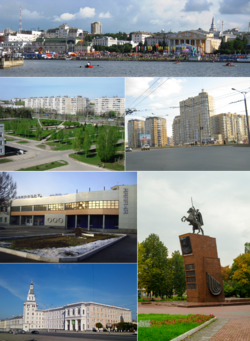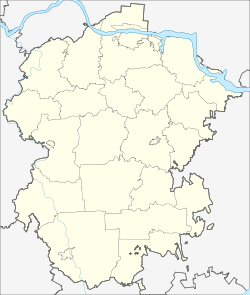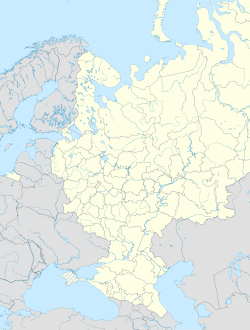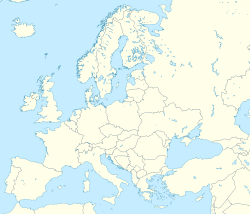Cheboksary[a] is the capital city of Chuvashia, Russia. It is a port on the Volga River.
Cheboksary
Чебоксары | |
|---|---|
| Other transcription(s) | |
| • Chuvash | Шупашкар |
 | |
| Anthem: Anthem of Cheboksary[2][3] | |
| Coordinates: 56°09′N 47°14′E / 56.150°N 47.233°E | |
| Country | Russia |
| Federal subject | Chuvashia[1] |
| First mentioned | 1469[4] |
| City status since | 1781[4] |
| Government | |
| • Body | City Assembly of Deputies[5] |
| • Head[5] | Oleg Nikolayev[6] |
| Area | |
• Total | 250.9 km2 (96.9 sq mi) |
| Elevation | 178 m (584 ft) |
| Population | |
• Total | 453,721 |
• Estimate (2018)[10] | 492,331 (+8.5%) |
| • Rank | 39th in 2010 |
| • Density | 1,800/km2 (4,700/sq mi) |
| • Subordinated to | city of republic significance of Cheboksary[1] |
| • Capital of | Chuvash Republic[1] |
| • Capital of | city of republic significance of Cheboksary[1] |
| • Urban okrug | Cheboksary Urban Okrug[11] |
| • Capital of | Cheboksary Urban Okrug[11] |
| Time zone | UTC+3 (MSK |
| Postal code(s)[13] | 428000–428006, 428008–428015, 428017–428025, 428027–428029,428031, 428032, 428034–428038, 428899, 428999, 996200 |
| Dialing code(s) | +7 8352 |
| OKTMO ID | 97701000001 |
| City Day | Third Sunday of August |
| Website | gov |
Geography
editThe city is located in the Volga Upland region and stands on the shore of the Cheboksary Reservoir. Its area is 250.9 square kilometers (96.9 sq mi).[7] The satellite city of Novocheboksarsk is located about 6 kilometers (3+1⁄2 mi) east of Cheboksary.
History
editCheboksary was first mentioned in written sources in 1469,[4] but according to archaeological excavations, the area had been populated much earlier. The site hosted a Bulgarian city of Veda Suvar, which appeared after Mongols defeated major Volga Bulgarian cities in the 13th century. During Khanate period the town is believed by some[who?] to have had a Turkic (probably, Tatar[citation needed]) name Çabaqsar and that the current Russian and English names originate from it. However, in maps by European travelers it was marked as Cibocar (Pizzigano, 1367), Veda-Suar (Fra Mauro, 1459). Shupashkar, the Chuvash name literally means the "fortress of the Chuvash".
In 1555, the Russians built a fortress and established a settlement here. In 1625, there were 458 soldiers quartered in Cheboksary, and in 1646 there were 661 males living in the settlement. At the end of the 17th century, Cheboksary was regarded as a major commercial city of the Volga region, and in 1781 it was granted town status[4] within Kazan Governorate. In the beginning of the 19th century the population was about 5500, the town had a sawmill and several small manufactures.
In the 16th and the first half of the 17th century the Vvedensky cathedral, four monasteries and eight churches had been built, in the 18th century the stone buildings of treasury and archive, magistracy, court, and ten churches. In 1880, here were counted 783 houses (33 of them from stone), 91 stores, three schools, two hospitals, and one bank.[citation needed]
In the beginning of the 20th century, 5,100 people lived in Cheboksary. In 1965, the population grew to 163,000.
Administrative and municipal status
editCheboksary is the capital of the republic.[1] Within the framework of administrative divisions, it is, together with two urban-type settlements (Novye Lapsary and Sosnovka) and two rural localities, incorporated as the city of republic significance of Cheboksary—an administrative unit with the status equal to that of the districts.[1] As a municipal division, the city of republic significance of Cheboksary is incorporated as Cheboksary Urban Okrug.[11]
City divisions
editFor administrative purposes, Cheboksary is divided into three city districts: Kalininskiy, Leninskiy, and Moskovskiy.
Demographics
edit| Year | Pop. | ±% |
|---|---|---|
| 1897 | 5,000 | — |
| 1926 | 9,000 | +80.0% |
| 1939 | 30,996 | +244.4% |
| 1959 | 104,374 | +236.7% |
| 1970 | 216,139 | +107.1% |
| 1979 | 307,599 | +42.3% |
| 1989 | 419,592 | +36.4% |
| 2002 | 440,621 | +5.0% |
| 2010 | 453,721 | +3.0% |
| 2021 | 497,807 | +9.7% |
| Source: Census data | ||
Population: 497,807 (2021 Census);[15] 453,721 (2010 Census);[9] 440,621 (2002 Census);[16] 419,592 (1989 Soviet census).[17]
The city of Cheboksary together with the satellite city Novocheboksarsk forms a polycentric agglomeration with a population of more than 680 thousand people.
Ethnic composition
editThe population of Cheboksary consists mainly of the two following ethnic groups; the Chuvash (62%), and ethnic Russians (34%).[18] Mixed marriages are quite common.
Culture
editCheboksary possesses many cultural opportunities. These include the Public Order (Badge of Honor) Russian Drama Theater, a philharmonic orchestra, the Chuvash State Puppet Theater and numerous theaters (showing productions in both Russian and Chuvash languages). However, a very popular gathering place for the locals is the recently[when?] completed zaliv (bay), situated in the middle of the city. Cheboksary also has boardwalks and beaches along the Volga River, where people swim in the summer. There are also a number of heated pools, health clubs, and museums (including the Chuvash National Museum and Russia's only beer museum).[19]
Cheboksary hosted a language festival in 1996.
Sport
editCheboksary regularly hosts athletics meetings and racewalking events, including the 2008 IAAF World Race Walking Cup, the 2015 European Team Championships Super League, and the 2016 Russian athletics and masters athletics championships.[20] The 2016 IAAF World Race Walking Team Championships were moved from Cheboksary to Rome as part of IAAF sanctions against doping in Russia.
Education
editEducational institutions include the Chuvash State University, Chuvash State Agriculture Academy, the Chuvash State Pedagogical University, and the Cheboksary Cooperative Technical School.
Economy
editCheboksary is located near the Cheboksary Dam generating up to 1,404 MW, with a reservoir of 2,274 square kilometers (878 sq mi). Cheboksary is the location of the headquarters of the Concern Tractor Plants, Russia's leading machine building company and one of the largest heavy mechanical engineering companies in the world.[19][21]
Transportation
editLocal public transportation
editAn extensive system of trolleybuses, autobuses, and minibuses covers the city, providing quick, convenient access to all parts of the city. For those who prefer taxis, there are several taxi agencies available, but the favorite means of transportation among locals are so-called "Gypsy" cabs. In Russia, anybody who owns a car is potentially a taxi. This can be a convenient way to get around but it is also potentially dangerous. Official taxis cost less than 6 dollars for travel between most points within the city.[19]
River
editBecause the Volga River runs through Chuvashia, Cheboksary is a frequent stop on the many boat tours that travel along the major cities up and down the Volga. To the south, Volgograd, Rostov-on-Don, Astrakhan, the Caspian Sea, and Black Sea are directly reachable. To the west, the Volga River connects Cheboksary with Nizhny Novgorod, Yaroslavl, Moscow, and the northern regions of Russia. By using river-sea vessels, it is possible to take cargo from Chuvash riverports all the way to Saint Petersburg, Novorossiysk (on the Black Sea), Astrakhan, and ports situated on the Danube river. However, the river is frozen from December to April.[19]
Air
editThe Cheboksary Airport (IATA CSY, ICAO UWKS, international airport since 1995) receives both cargo and passenger aircraft of practically all types and sizes. There are regularly scheduled flights to Moscow and other destinations. Chuvashia Airlines was based at this airport until operations ceased in 2009. Cheboksary is located about a four-hour drive from Strigino International Airport near Nizhny Novgorod, which offers more flight connections.
Climate
editThe climate in the region is continental (Köppen: Dfb), and it is similar to the climate in Moscow, although colder in winter, which lasts from late November until late March with a permanent snow cover.
| Climate data for Cheboksary (1991–2020 normals, extremes 1929–present) | |||||||||||||
|---|---|---|---|---|---|---|---|---|---|---|---|---|---|
| Month | Jan | Feb | Mar | Apr | May | Jun | Jul | Aug | Sep | Oct | Nov | Dec | Year |
| Record high °C (°F) | 4.7 (40.5) |
5.0 (41.0) |
13.5 (56.3) |
28.6 (83.5) |
32.6 (90.7) |
36.4 (97.5) |
38.6 (101.5) |
39.9 (103.8) |
29.7 (85.5) |
25.0 (77.0) |
13.4 (56.1) |
7.0 (44.6) |
39.9 (103.8) |
| Mean daily maximum °C (°F) | −7.3 (18.9) |
−6.6 (20.1) |
−0.3 (31.5) |
9.9 (49.8) |
18.9 (66.0) |
22.5 (72.5) |
24.9 (76.8) |
22.5 (72.5) |
16.2 (61.2) |
7.9 (46.2) |
−0.6 (30.9) |
−5.6 (21.9) |
8.5 (47.3) |
| Daily mean °C (°F) | −10.0 (14.0) |
−9.6 (14.7) |
−3.6 (25.5) |
5.3 (41.5) |
13.4 (56.1) |
17.5 (63.5) |
19.7 (67.5) |
17.4 (63.3) |
11.7 (53.1) |
4.7 (40.5) |
−2.8 (27.0) |
−8.0 (17.6) |
4.6 (40.3) |
| Mean daily minimum °C (°F) | −12.7 (9.1) |
−12.4 (9.7) |
−6.6 (20.1) |
1.3 (34.3) |
8.3 (46.9) |
12.7 (54.9) |
14.9 (58.8) |
13.0 (55.4) |
8.0 (46.4) |
2.1 (35.8) |
−4.8 (23.4) |
−10.4 (13.3) |
1.1 (34.0) |
| Record low °C (°F) | −42.3 (−44.1) |
−42.2 (−44.0) |
−32.5 (−26.5) |
−21.4 (−6.5) |
−5.1 (22.8) |
−4.8 (23.4) |
1.7 (35.1) |
−1.5 (29.3) |
−7.5 (18.5) |
−15.3 (4.5) |
−29.9 (−21.8) |
−44.3 (−47.7) |
−44.3 (−47.7) |
| Average precipitation mm (inches) | 32 (1.3) |
24 (0.9) |
29 (1.1) |
33 (1.3) |
41 (1.6) |
64 (2.5) |
70 (2.8) |
59 (2.3) |
51 (2.0) |
58 (2.3) |
43 (1.7) |
36 (1.4) |
540 (21.3) |
| Average rainy days | 2 | 0 | 3 | 10 | 16 | 15 | 13 | 12 | 20 | 15 | 11 | 10 | 127 |
| Average snowy days | 25 | 16 | 16 | 4 | 0 | 0 | 0 | 0 | 0 | 7 | 14 | 23 | 105 |
| Average relative humidity (%) | 85 | 80 | 79 | 58 | 56 | 59 | 52 | 62 | 74 | 79 | 87 | 86 | 71 |
| Source: Погода и Климат[22] | |||||||||||||
Media
edit- «To health via culture» — Journal of the World Health Culture Organization.[23][24]
Gallery
edit-
The new Government House of the Chuvash Republic
-
The Chuvash State Opera and Ballet Theater
-
Chuvash State Art Museum
-
Chuvash National Library
-
Chuvashia Hotel
-
Chuvash Drama Theater
-
Assumption Church
-
Mother Patroness Monument in center of the city
-
Monument of Vasily Chapaev
-
Cheboksary railway station before reconstruction
-
Chuvash State Puppet Theater
-
Vvedensky Cathedral
-
Old house, architectural monument
-
the old house of the merchant Kadomtsev
-
The oldest pharmacy Cheboksary
-
Peasant's House
Notable people
edit- Marie Vorobieff (1892-1984), Russian-born painter
- Andriyan Nikolayev (1929—2004), Soviet cosmonaut
- Daniil Orain (born 2000), Russian journalist
- Yuri Yevlampyev (born 1966), former Russian professional footballer
Twin towns – sister cities
editCheboksary is twinned with:[25][26]
- Afyonkarahisar, Turkey
- Eger, Hungary
- Grodno, Belarus
- Rundu, Namibia
- Santa Clara, Cuba
References
editNotes
edit- ^ /ˌtʃɛbɒkˈsɛəri/; Russian: Чебоксары [tɕɪbɐkˈsarɨ]; Chuvash: Шупашкар, romanized: Şupaşkar
Citations
edit- ^ a b c d e f g Law #28
- ^ Charter of Cheboksary, Article 4
- ^ Decision #1525
- ^ a b c d Энциклопедия Города России. Moscow: Большая Российская Энциклопедия. 2003. pp. 510–512. ISBN 5-7107-7399-9.
- ^ a b Charter of Cheboksary, Article 23
- ^ Official website of Cheboksary. Leonid Ilyich Cherkesov, Head of the City of Cheboksary (in Russian)
- ^ a b Resolution #2083
- ^ https://it-ch.topographic-map.com/map-fqflzs/%D0%A7%D0%B5%D0%B1%D0%BE%D0%BA%D1%81%D0%B0%D1%80%D1%8B/?zoom=19¢er=56.12833%2C47.27548&popup=56.1285%2C47.27552.
{{cite web}}: Missing or empty|title=(help) - ^ a b Russian Federal State Statistics Service (2011). Всероссийская перепись населения 2010 года. Том 1 [2010 All-Russian Population Census, vol. 1]. Всероссийская перепись населения 2010 года [2010 All-Russia Population Census] (in Russian). Federal State Statistics Service.
- ^ "26. Численность постоянного населения Российской Федерации по муниципальным образованиям на 1 января 2018 года". Federal State Statistics Service. Retrieved January 23, 2019.
- ^ a b c Law #37
- ^ "Об исчислении времени". Официальный интернет-портал правовой информации (in Russian). June 3, 2011. Retrieved January 19, 2019.
- ^ Почта России. Информационно-вычислительный центр ОАСУ РПО. (Russian Post). Поиск объектов почтовой связи (Postal Objects Search) (in Russian)
- ^ Chuvash Republic Territorial Branch of the Federal State Statistics Service. Численность населения на 1 января 2014 года (in Russian)
- ^ Russian Federal State Statistics Service. Всероссийская перепись населения 2020 года. Том 1 [2020 All-Russian Population Census, vol. 1] (XLS) (in Russian). Federal State Statistics Service.
- ^ Federal State Statistics Service (May 21, 2004). Численность населения России, субъектов Российской Федерации в составе федеральных округов, районов, городских поселений, сельских населённых пунктов – районных центров и сельских населённых пунктов с населением 3 тысячи и более человек [Population of Russia, Its Federal Districts, Federal Subjects, Districts, Urban Localities, Rural Localities—Administrative Centers, and Rural Localities with Population of Over 3,000] (XLS). Всероссийская перепись населения 2002 года [All-Russia Population Census of 2002] (in Russian).
- ^ Всесоюзная перепись населения 1989 г. Численность наличного населения союзных и автономных республик, автономных областей и округов, краёв, областей, районов, городских поселений и сёл-райцентров [All Union Population Census of 1989: Present Population of Union and Autonomous Republics, Autonomous Oblasts and Okrugs, Krais, Oblasts, Districts, Urban Settlements, and Villages Serving as District Administrative Centers]. Всесоюзная перепись населения 1989 года [All-Union Population Census of 1989] (in Russian). Институт демографии Национального исследовательского университета: Высшая школа экономики [Institute of Demography at the National Research University: Higher School of Economics]. 1989 – via Demoscope Weekly.
- ^ Национальный состав населения районов и городов Чувашской Республики по данным переписи населения 2002 года
- ^ a b c d Steven Brown and Olin Lagon (June 2001). "Economic Overview of the Republic of Chuvashia". United States Peace Corps Business Development Volunteers in Chuvashia. Archived from the original on July 4, 2005. Retrieved January 10, 2009.
- ^ Ebel, Francesca; Silchenko, Veronika (June 19, 2016). "Despair and defiance as Russian athletes react to doping ban". Associated Press. Retrieved October 18, 2017.
- ^ "Company Profile". Concern Tractor Plants. Archived from the original on May 23, 2009. Retrieved July 14, 2009.
- ^ "Climate Cheboksary". Pogoda.ru.net. Retrieved November 5, 2021.
- ^ "To health via culture: journal of the World Health Culture Organization". catalog.loc.gov. 1995. ISSN 0204-3440. Retrieved July 19, 2024.
- ^ "To Health via culture". rsl.ru. 1995. ISSN 0204-3440. Retrieved July 17, 2024.
- ^ "Города - побратимы г. Чебоксары". gcheb.cap.ru (in Russian). Cheboksary. Retrieved February 2, 2020.
- ^ "Kardeş Şehir Hamm". afyon.bel.tr (in Turkish). Afyonkarahisar. Retrieved February 2, 2020.
Sources
edit- Государственный Совет Чувашской Республики. Закон №28 от 19 декабря 1997 г. «Об административно-территориальном устройстве Чувашской Республики», в ред. Закона №37 от 30 июля 2013 г. «О внесении изменений в отдельные законодательные акты Чувашской Республики и признании утратившим силу Закона Чувашской Республики "О едином балансе активов и пассивов Чувашской Республики"». Вступил в силу со дня официального опубликования. Опубликован: "Ведомости Государственного Совета ЧР", №23, 1998. (State Council of the Chuvash Republic. Law #28 of December 19, 1997 On the Administrative-Territorial Structure of the Chuvash Republic, as amended by the Law #37 of July 30, 2013 On Amending Several Legislative Acts of the Chuvash Republic and on Abrogating the Law of the Chuvash Republic "On Consolidated Balance of Assets and Liabilities of the Chuvash Republic". Effective as of the official publication date.).
- Государственный Совет Чувашской Республики. Закон №37 от 24 ноября 2004 г. «Об установлении границ муниципальных образований Чувашской Республики и наделении их статусом городского, сельского поселения, муниципального района и городского округа», в ред. Закона №54 от 9 октября 2015 г. «О внесении изменений в Закон Чувашской Республики "Об установлении границ муниципальных образований Чувашской Республики и наделении их статусом городского, сельского поселения, муниципального района и городского округа"». Вступил в силу через 10 дней со дня официального опубликования. Опубликован: "Республика", №49-50, 30 ноября 2004 г. (State Council of the Chuvash Republic. Law #37 of November 24, 2004 On Establishing the Borders of the Municipal Formations of the Chuvash Republic and on Granting Them Status of Urban, Rural Settlement, Municipal District, and Urban Okrug, as amended by the Law #54 of October 9, 2015 On Amending the Law of the Chuvash Republic "On Establishing the Borders of the Municipal Formations of the Chuvash Republic and on Granting Them Status of Urban, Rural Settlement, Municipal District, and Urban Okrug". Effective as of the day which is 10 days after the official publication date.).
- Чебоксарское городское Собрание депутатов. Решение №40 от 30 ноября 2005 г. «Устав муниципального образования города Чебоксары — столицы Чувашской Республики», в ред. Решения №1743 от 20 ноября 2014 г. «О внесении изменений в Устав муниципального образования города Чебоксары — столицы Чувашской Республики». Вступил в силу 1 января 2006 г. (за исключением отдельных положений). Опубликован: "Чебоксарские новости", №255–260, 31 декабря 2005 г. (Cheboksary City Assembly of Deputies. Decision #40 of November 30, 2005 Charter of the Municipal Formation of the City of Cheboksary—the Capital of the Chuvash Republic, as amended by the Decision #1743 of November 20, 2014 On Amending the Charter of the Municipal Formation of the City of Cheboksary—the Capital of the Chuvash Republic. Effective as of January 1, 2006 (with the exception of certain clauses).).
- Чебоксарское городское Собрание депутатов. Решение №1525 от 24 декабря 2009 г. «О гимне муниципального образования города Чебоксары — столицы Чувашской Республики». Вступил в силу со дня официального опубликования. Опубликован: "Чебоксарские новости", №148–149, 29 декабря 2009 г. (Cheboksary City Assembly of Deputies. Decision #1525 of December 24, 2009 On the Anthem of the Municipal Formation of the City of Cheboksary—the Capital of the Chuvash Republic. Effective as of the day of the official publication.).
- Администрация города Чебоксары Чувашской Республики. Постановление №2083 от 1 июля 2013 г. «О социальном паспорте города Чебоксары за 2012 год». Опубликован: "Вестник органов местного самоуправления города Чебоксары", №12, 10 июля 2013 г. (Administration of the City of Cheboksary of the Chuvash Republic. Resolution #2083 of July 1, 2013 On the 2012 Social Passport of the City of Cheboksary. ).
External links
edit- Official website of Cheboksary (in Russian)
- Cheboksary Business Directory (in Russian)
- Photos from Cheboksary





